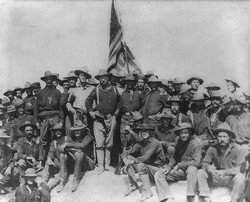Historians have hailed Theodore Roosevelt Rough Rider co-founder and leader, as an American military hero. His bravery during the Spanish American War, along with his ability to ‘rally the troops’ led to his nomination for the Medal of Honor in 1898.
In 1898, the U.S. found itself in the midst of an impending war between Spain and Cuba. Due to an explosion aboard the battleship Maine on February 15, 1898, more than three-quarters of the American crew were killed, in the bay of Havana, Cuba. As conflicting stories emerged about the cause of the explosion, yellow journalism stories in New York – ordered by competing newspaper owners William Randolph Hearst and Joseph Pulitzer – were effectively inciting the demand for violent response to Spain, among average citizens. Having been appointed as the Assistant Secretary of Navy in 1897 by President William McKinley, Teddy was suddenly in the unexpected position to do something about the situation. Just before the explosion, the Secretary of the Navy – John D. Long – left the office, announcing he would return in several hours. During his absence, Theodore was able to assume the position of Acting Secretary of the Navy and played an instrumental role in moving the U.S. closer to war with Spain.
Because of the underlying current of unrest, and amid consistent calls for action, Congress finally declared the existence of war with Spain as of April 21, 1898. Shortly thereafter, Theodore resigned his post as Assistant Secretary of the Navy, and – along with Colonel Leonard Wood, U.S. Army – began assembling an all-volunteer group of men who would join in the fight against Spain. Although the official title for this group was the First U.S. Volunteer Cavalry Regiment, the press later named them the “Rough Riders”, after a famous western show of the time, led by Buffalo Bill. These men came from all walks of life, boasting a veritable who’s-who of backgrounds and titles. Some were gentlemen from Boston or New York, friends from Teddy’s Ivy League days. Others were athletes in sports such as polo, golf, baseball, and football. Still others were more of the ‘average man’ type: miners, cowboys, hunters, and Indians.
After the troops were assembled, they received all of their equipment, supplies, horses and weapons from the Quartermaster Depot in Fort Sam Houston, and began training in San Antonio, Texas. Following training, they received orders to Cuba in May 1898. Despite an arduous train ride to Florida, and subsequent delay, Theodore Roosevelt and the Rough Riders arrived in Daiquiri on June 23. The next day, the regiment faced its first test under fire at the Battle of Las Guasimas, proving they were both effective and cohesive. Later, on July 1, they proved their mettle during the advance on Kettle Hill and the Battle of San Juan Hill. Joining other regiments and troops in the area, the “Rough Riders” helped make the Siege of Santiago a success, causing the sinking of Spanish cruisers and later forcing the Spanish forces to surrender to General Shafter and the U.S. military. The Spanish government officially surrendered on August 12, 1898, with an agreement to forego their control of Cuba and give the U.S. Puerto Rico, Guam, and the Philippines.
